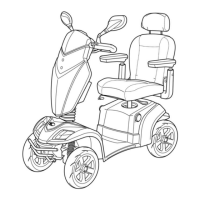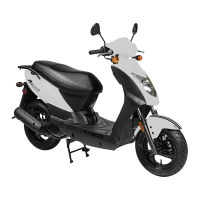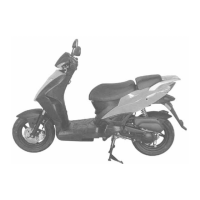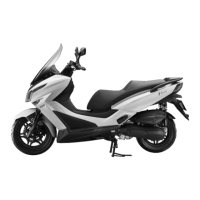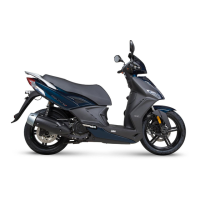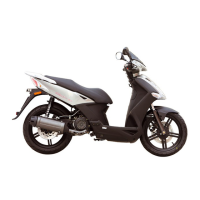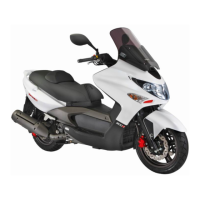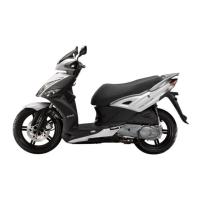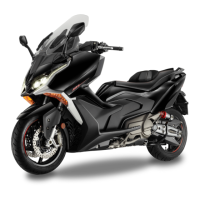
 Loading...
Loading...
Do you have a question about the KYMCO AK550 Premium E5 2023 and is the answer not in the manual?
| Displacement | 550.4 cc |
|---|---|
| Cooling System | Liquid-cooled |
| Fuel System | Electronic Fuel Injection |
| Transmission | CVT |
| Front Brake | Dual disc, ABS |
| Rear Brake | Single disc, ABS |
| Front Tire | 120/70-15 |
| Rear Tire | 160/60-15 |
| Seat Height | 785 mm |
| Wheelbase | 1, 580 mm |
| Engine Type | 4-stroke, DOHC, 8-valve, parallel twin |
| Rear Suspension | Horizontal trailing arm |
| Weight | 226 kg |
| Max Torque | 52.3 Nm @ 5750 rpm |
Record engine and frame numbers for spare parts and vehicle identification.
Location and engraving details of the engine number on the crank box.
Location and imprint details of the frame number on the vehicle.
Details on load limits and tire pressure markings on the motorcycle.
Information on ECU data collection and its usage for diagnosis and troubleshooting.
Identifies key components visible from the left side of the scooter.
Identifies key components visible from the right side of the scooter.
Explains the controls and indicators on the left handlebar.
Explains the controls and indicators on the right handlebar.
Details the switches located in the center console area.
Location and operation of the main power switch.
Overview of all indicators and displays on the scooter's dashboard.
Explains display units, trip meters, and service mileage indicators.
Indicates engine speed in RPM.
Alerts for low or high tire pressure.
Indicates the status of the Traction Control System.
Operation of the low beam headlight function.
Functionality and settings for maintaining a set speed.
Selection of different riding modes affecting engine performance.
Activation and selection of handlebar heating levels.
Indicates when the parking brake is engaged.
Operation of the right turn signal.
Warning light for engine system status.
Covers oil/belt service, oil pressure, ABS, water temp, speedometer, and fuel gauge.
Instructions for downloading and setting up the Noodoe app and system.
Explanation of various features and capabilities of the Noodoe system.
Detailed guide on using buttons for Noodoe functions.
Steps to pair the Noodoe system with a smartphone.
Process of installing user-created dashboard displays.
Overview of app features like Home/Feed, Create Mode, and Profile.
Customization options for dashboard displays using templates and images.
Feature to locate a parked scooter using the app.
How incoming phone messages are displayed on the scooter dashboard.
Function to help identify the scooter in parking lots or at night.
Guide on how to replace the battery in the keyless remote.
Describes the effective range for remote sensing.
Describes the proximity sensing range for unlocking.
Procedure for locking the vehicle using the keyless system.
Procedure for unlocking the vehicle using the keyless system.
Using the short-range sensor to unlock the vehicle.
Steps to lock the steering stem for anti-theft.
Steps to unlock the steering stem.
Function to activate hazard lights for parking.
Button to cycle through different meter displays.
Navigates and selects options within the Noodoe system.
Scrolls through Noodoe information on the dashboard.
Button to switch between Noodoe modes.
Button to start the engine.
Controls for activating and adjusting handlebar heating levels.
Settings and execution for cruise control functions.
Operation of blinkers, headlights, windshield adjuster, and horn.
How to open the storage box electronically using the main switch.
Details about the LED light and storage capacity warnings.
Steps for removing the front windshield protection cover.
Importance and adjustment of rear view mirrors for safety.
Usage and safety precautions for the 12V accessory socket.
Correct procedure for using the main stand for parking.
Instructions for opening, closing, and securing the fuel filler cap.
How the Tire Pressure Monitoring System works and its basic indicators.
Procedure for re-registering tire pressure sensors.
How to switch units for tire pressure readings.
Interpreting dashboard messages for TPMS errors.
How the Anti-lock Braking System works and its indicators.
Operation and indicators for the Traction Control System.
Explanation of the Advanced Integrated Brake System.
Overview of the Traction Control System's purpose and operation.
Explanation of O2 sensor, muffler, and catalytic converter.
Components and purpose of the emissions control system.
Step-by-step guide to starting the scooter's engine.
Proper technique for releasing the brake levers before moving.
Proper use of front and rear brakes, including warnings.
Safe procedures for approaching and parking the vehicle.
Detailed steps for securing the vehicle using the main stand.
Procedure for restarting a vehicle after it has tipped over.
Checking and maintaining engine oil levels and filter.
Verifying the steering stem for looseness or tightness.
Adjusting and checking front/rear brake levers and pedals.
Checking brake fluid level and procedure for replenishment.
Inspecting brake pad wear limits and tire condition/pressure.
Verifying the operation of brake lights and tail lights.
Ensuring headlights and turn signals function correctly.
Inspecting the front fork and suspension for smooth operation.
Checking the drive belt for wear and proper tension.
Ensuring the side stand functions correctly and safely.
Schedule for routine maintenance tasks based on mileage/time.
Torque specs, wheel/tire/coolant checks, and belt maintenance.
How to check battery voltage and replace the battery.
Procedure for cleaning battery terminals and safety precautions.
Fuse replacement procedure and specifications.
Steps for replacing the air filter element.
How to clean or replace the CVT transmission filter wool.
User precautions, oil change schedule, and specifications.
How to check, clean, adjust, and replace the spark plug.
Checking coolant level and procedure for adding coolant.
Steps to take when the engine does not start or stops while riding.
Explanation of the vehicle's emission control system.
Function and maintenance of the EEC system for pollution control.
Details on CE, FCC, JRF, KCC, NCC, and SRRC certifications.
Key technical data including engine type, dimensions, weight, and tire sizes.
